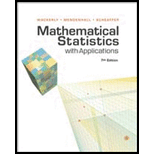
Concept explainers
Suppose that Y1 is the total time between a customer’s arrival in the store and departure from the service window, Y2 is the time spent in line before reaching the window, and the joint density of these variables (as was given in Exercise 5.15) is
- a Find the marginal density
functions for Y1 and Y2. - b What is the conditional density function of Y1 given that Y2 = y2? Be sure to specify the values of y2 for which this conditional density is defined.
- c What is the conditional density function of Y2 given that Y1 = y1? Be sure to specify the values of y1 for which this conditional density is defined.
- d Is the conditional density function f(y1|y2) that you obtained in part (b) the same as the marginal density function f1(y1) found in part (a)?
- e What does your answer to part (d) imply about marginal and conditional probabilities that Y1 falls in any interval?
5.15 The management at a fast-food outlet is interested in the joint behavior of the random variables Y1, defined as the total lime between a customer’s arrival at the store and departure from the service window, and Y2, the lime a customer waits in line before reaching the service window. Because Y1 includes the time a customer waits in line, we must have Y1 ≥ Y2. The relative frequency distribution of observed values of Y1 and Y2 can be modeled by the
with time measured in minutes. Find
- a P(Y1 < 2, Y2 > 1).
- b P(Y1 ≥ 2Y2).
- c P(Y1 – Y2 ≥ 1). (Notice that Y1 – Y2 denotes the time spent at the service window.)
Trending nowThis is a popular solution!

Chapter 5 Solutions
Mathematical Statistics with Applications
- A company found that the daily sales revenue of its flagship product follows a normal distribution with a mean of $4500 and a standard deviation of $450. The company defines a "high-sales day" that is, any day with sales exceeding $4800. please provide a step by step on how to get the answers in excel Q: What percentage of days can the company expect to have "high-sales days" or sales greater than $4800? Q: What is the sales revenue threshold for the bottom 10% of days? (please note that 10% refers to the probability/area under bell curve towards the lower tail of bell curve) Provide answers in the yellow cellsarrow_forwardFind the critical value for a left-tailed test using the F distribution with a 0.025, degrees of freedom in the numerator=12, and degrees of freedom in the denominator = 50. A portion of the table of critical values of the F-distribution is provided. Click the icon to view the partial table of critical values of the F-distribution. What is the critical value? (Round to two decimal places as needed.)arrow_forwardA retail store manager claims that the average daily sales of the store are $1,500. You aim to test whether the actual average daily sales differ significantly from this claimed value. You can provide your answer by inserting a text box and the answer must include: Null hypothesis, Alternative hypothesis, Show answer (output table/summary table), and Conclusion based on the P value. Showing the calculation is a must. If calculation is missing,so please provide a step by step on the answers Numerical answers in the yellow cellsarrow_forward
 Linear Algebra: A Modern IntroductionAlgebraISBN:9781285463247Author:David PoolePublisher:Cengage Learning
Linear Algebra: A Modern IntroductionAlgebraISBN:9781285463247Author:David PoolePublisher:Cengage Learning
